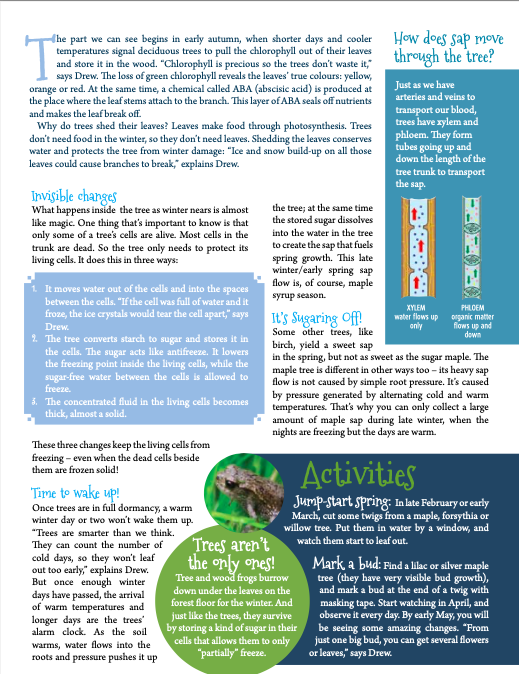

Do Trees Hibernate?
Trees don’t generate their own heat like mammals do, and they don’t have warm burrows or fur coats to snuggle into. So how do they survive the deep- freeze of winter?
In a way they do hibernate, like bears – but in trees this is called dormancy. By going dormant, the trees save energy and protect themselves from freezing. Just how they do that, though, is pretty amazing. Brainspace talked to naturalist and nature writer Drew Monkman to find out more.
The part we can see begins in early autumn, when shorter days and cooler temperatures signal deciduous trees to pull the chlorophyll out of their leaves and store it in the wood. “Chlorophyll is precious so the trees don’t waste it,” says Drew. The loss of green chlorophyll reveals the leaves’ true colours: yellow, orange or red. At the same time, a chemical called ABA (abscisic acid) is produced at the place where the leaf stems attach to the branch. This layer of ABA seals off nutrients and makes the leaf break off.
Why do trees shed their leaves? Leaves make food through photosynthesis. Trees don’t need food in the winter, so they don’t need leaves. Shedding the leaves conserves water and protects the tree from winter damage: “Ice and snow build-up on all those leaves could cause branches to break,” explains Drew.
Invisible changes
What happens inside the tree as winter nears is almost like magic. One thing that’s important to know is that only some of a tree’s cells are alive. Most cells in the trunk are dead. So the tree only needs to protect its living cells. It does this in three ways:
- It moves water out of the cells and into the spaces between the cells. “If the cell was full of water and it froze, the ice crystals would tear the cell apart,” says Drew.
- The tree converts starch to sugar and stores it in the cells. The sugar acts like antifreeze. It lowers the freezing point inside the living cells, while the sugar-free water between the cells is allowed to freeze.
- The concentrated fluid in the living cells becomes thick, almost a solid.
These three changes keep the living cells from freezing – even when the dead cells beside them are frozen solid!
Time to wake up!
Once trees are in full dormancy, a warm winter day or two won’t wake them up. “Trees are smarter than we think. They can count the number of cold days, so they won’t leaf out too early,” explains Drew. But once enough winter days have passed, the arrival of warm temperatures and longer days are the trees’ alarm clock. As the soil warms, water flows into the roots and pressure pushes it up the tree; at the same time the stored sugar dissolves into the water in the tree to create the sap that fuels spring growth. This late winter/early spring sap flow is, of course, maple syrup season.
It’s Sugaring Off!
Some other trees, like birch, yield a sweet sap in the spring, but not as sweet as the sugar maple. The maple tree is different in other ways too – its heavy sap flow is not caused by simple root pressure. It’s caused by pressure generated by alternating cold and warm temperatures. That’s why you can only collect a large amount of maple sap during late winter, when the nights are freezing but the days are warm.
How does sap move through the tree?
Just as we have arteries and veins to transport our blood, trees have xylem and phloem. They form tubes going up and down the length of the tree trunk to transport the sap.
